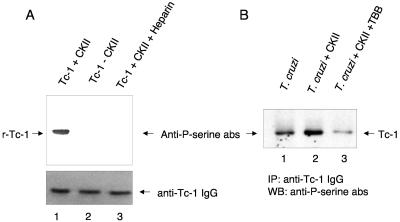FIG. 6.
Human exogenous CKII phosphorylates recombinant Tc-1 or Tc-1 of intact T. cruzi trypomastigotes on serine residues, and the phosphorylation is inhibited by the CKII inhibitor heparin or TBB. (A) Phosphorylation of recombinant Tc-1 (r-Tc-1) by exogenous CKII. Recombinant Tc-1 (40 μg) was incubated with 20 ng of human CKII, with phosphorylation buffer in place of CKII, or with 20 ng CKII in the presence of heparin, a CKII inhibitor, for 10 min at 30°C. The same amount of each sample was separated by SDS-PAGE, blotted onto nitrocellulose membranes, probed with anti-phosphoserine antibodies (Anti-P-serine abs), and developed by ECL as described in Materials and Methods. Lane 1 shows the phosphorylation of serine residues on Tc-1 by CKII. Lane 2 (control) shows that Tc-1 is not phosphorylated in the presence of reaction buffer alone. Lane 3 shows that heparin inhibits the phosphorylation of Tc-1 by CKII. This is a representative experiment of three experiments performed with similar results. (B) Trypomastigotes (7 × 107) were starved in DMEM and incubated with 20 ng of human CKII, with phosphorylation buffer in place of CKII, or with 20 ng CKII in the presence of TBB, a CKII inhibitor, for 10 min at 30°C. The same protein concentration of solubilized samples was immunoprecipitated (IP) with anti-Tc-1 IgG, separated by SDS-PAGE, blotted onto nitrocellulose membranes, probed with anti-phosphoserine antibodies, and developed by ECL. Lane 1 (control) shows endogenous phosphorylation of serine residues on Tc-1 of trypomastigotes in the absence of exogenous CKII. Lane 2 shows the phosphorylation of serine residues on Tc-1 of intact T. cruzi by exogenous CKII. Lane 3 shows that TBB inhibits the phosphorylation of Tc-1 on intact T. cruzi by exogenous CKII. This is a representative experiment of three experiments performed with similar results. WB, Western blot.

